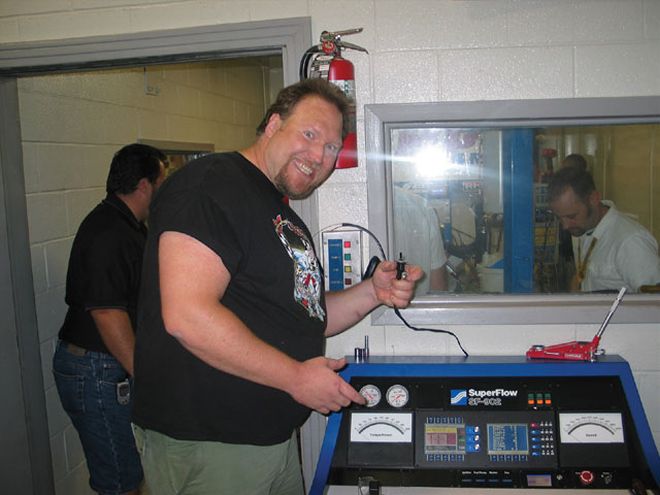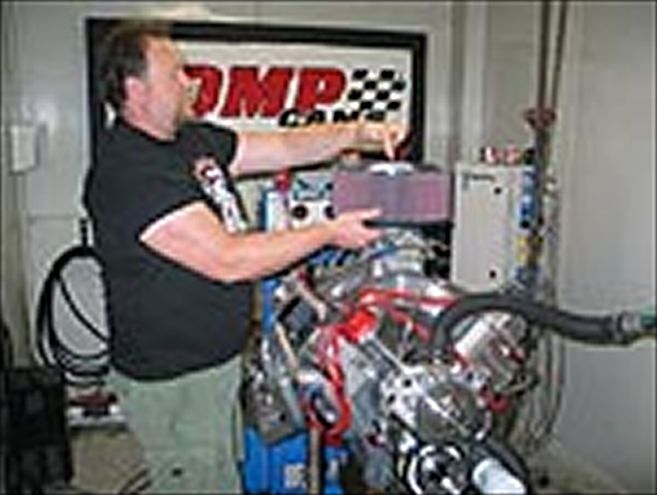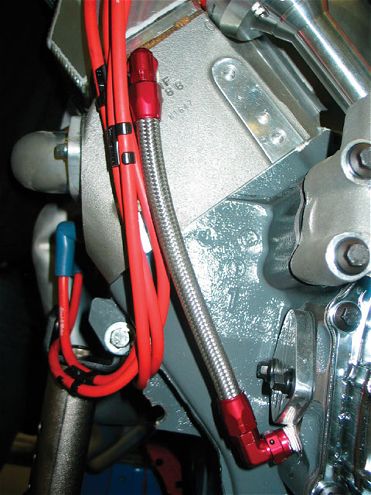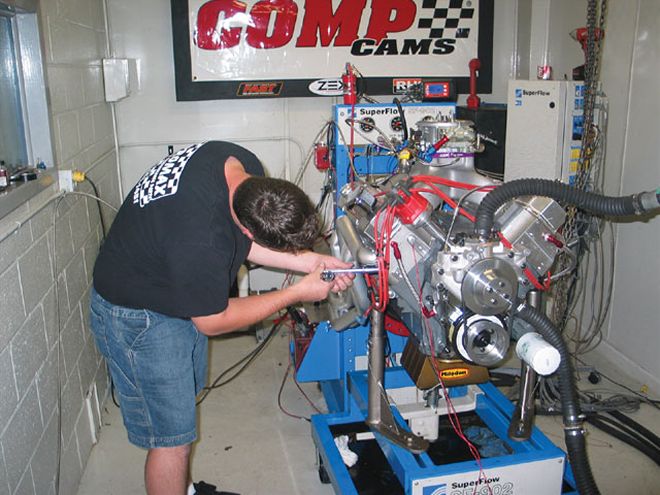
Those of you who have followed our engine challenge already know the 500ci big-blocks featured this year far exceeded our expectations in terms of raw power. Even more impressive is the fact that these engines made their big numbers running on Rockett Brand's 93-octane pump gas.
 The efficiency of Comp's dyno crew got us a little ahead of schedule, so August Cedarstrand of Speed-O-Motive made a deal with Comp to test their ZEX 300hp, nitrous-oxide kit just for fun. Though the use of nitrous wasn't legal for the contest, it sure was fun to watch a Mopar engine set the horsepower record on Comp's fairly new dyno.
The efficiency of Comp's dyno crew got us a little ahead of schedule, so August Cedarstrand of Speed-O-Motive made a deal with Comp to test their ZEX 300hp, nitrous-oxide kit just for fun. Though the use of nitrous wasn't legal for the contest, it sure was fun to watch a Mopar engine set the horsepower record on Comp's fairly new dyno.
This month, we'll go inside the engines of Mopar Engines West and Speed-O-Motive that placed fifth and sixth, respectively, in our challenge. Both these engines represent powerful and durable combinations, though the building techniques were somewhat different. Mopar Engines West holds the record for the most power and torque-their engine screamed to more than 761 hp and 656 lb-ft of torque. The Speed-O-Motive entry was somewhat milder, making more than 716 hp, but then proceeded to set Comp's dyno record with the use of a ZEX 300hp, nitrous-oxide kit.
Mopar Engines West, Newark, Ca
Founded in 2001 by Richard Nedbal, Newark, California's Mopar Engines West has been catering to the Mopar community since its inception. Richard began racing in 1963 and quickly learned that Mopar power wins races. He's been a fanatic ever since. While working as an integrated circuit engineer designing electronic fuel-injection systems, Richard built engines as a hobby. After selling his software company, he decided the Mopar community needed an engine shop with "high-tech" capability so he started Mopar Engines West.
In 2005, Richard merged his company with experienced engine builder and machinist David Timmon's shop, forming one of the best Mopar engine shops in the country. David's experience, matched with Richard's high-tech computer work, means that no project is too complex for Mopar Engines West. Examples such as the 8-CNC fuel-injected stack wedge in the now famous GTX-R or the 300hp fuel-injected Slant Six that we covered in Mopar Muscle demonstrate these guys are on the cutting edge of technology.
The Bottom End
Utilizing a factory block as the foundation for their build, the crew at Mopar Engines West paid attention to every detail when machining and assembling the bottom end of their engine. An Eagle 4.15-inch stroke crankshaft and factory RB length Eagle H-beam rods were utilized with SRP flat-top pistons for a final compression ratio of 12:1 with pistons installed 0.050-inch in the hole. The pistons were coated by Calico with a friction-reducing coating on the skirts and a thermal-barrier coating on the tops. Knowing that proper oil control equals free power, engine builder David Timmons spent considerable time customizing the oil system of this engine. Oil was restricted to the top end of the engine, and the valley area was sealed to keep oil from draining back over the cam and rotating assembly. He also custom built a crank scraper to work in conjunction with the Milodon windage tray and oil pan. A single-line, external pickup was utilized to direct oil to the Melling pump, which was blueprinted and modified to reduce oil pressure. Obviously building this engine for maximum power, the team at Mopar Engines West chose a rather large, solid-roller camshaft custom ground by Comp Cams. With 1.6 ratio rockers, lift numbers were in the 0.830-inch range on both the intake and exhaust valves. Duration at 0.050-inch lift measures 276-degrees intake and 278-degrees exhaust with a lobe separation of 105 degrees.
The Top End
Mopar racers and engine builders alike know that Indy heads make power. For this reason, Mopar Engines West chose Indy's 440-1 cylinder heads for their build. The long-valve design of the Indy heads means intake ports can be enlarged significantly, thereby increasing flow. Exhaust ports are also raised, and port volume of the Indy heads is significantly higher than anything produced by the factory. Ferrea valves were used with Comp 946 valvesprings and were actuated by Indy's 1.6 ratio rocker arms. The most significant modification to the cylinder heads, however, was the port work performed by engine builder David Timmon's daughter Angie, who had been to Joe Mondello's cylinder head school and spent some 40 hours hand porting not only the intake and exhaust ports, but also the combustion chambers of these heads. During the post dyno inspection it was apparent the modifications worked, as burn patterns on the piston tops and in the combustion chambers indicated a very efficient burn. The Indy 440-2 intake manifold was also ported, as well as the spacer between the carburetor and the intake. A Holley 1250-cfm race Dominator took care of the fuel-mixing duties, and an MSD distributor was modified in-house to achieve timing curves suitable to both the rpm range of our contest and the relatively high 12:1 compression of the engine. Overall, this engine impressed us with power, efficiency, and reliability, and we congratulate Mopar Engines West for their impressive performance.
 Speed-O-Motive's August Cedarstrand brought a reliable and well-tuned engine to this year's contest, landing a sixth place finish overall.
Speed-O-Motive's August Cedarstrand brought a reliable and well-tuned engine to this year's contest, landing a sixth place finish overall.
Speed-O-Motive, West Covina, Ca
Speed-O-Motive, based in West Covina, California, has been involved in the automotive aftermarket since the inception of hot-rodding during the '40s. They are known for providing powerful and reliable high-performance engines, and their entry in this year's contest was no exception. The Speed-O-Motive shop is equipped with state-of-the-art equipment, and they are able to handle any of their customer's needs, whether building a stock small-block or an exotic, stroked big-block.
For this year's challenge, the guys at Speed-O-Motive decided to try something a little different. As the only entry to run Brodix cylinder heads, Speed-O-Motive showed us there are many ways to attain killer power from the Mopar wedge engine. As expected, this engine ran great right out of the box with no tuning necessary.
The Bottom End
Like all of this year's competitors, Speed-O-Motive utilized a well-seasoned block for their engine challenge build. Their '74 vintage block was fully machined on Speed-O-Motive's Rottler equipment. After align-boring the block and clearancing it for the stroker crank, the cylinders were bored and honed with torque plates, and the main webbing was machined for aftermarket, Milodon main caps. A Speed-O-Motive brand, 4.15-inch stroke crankshaft was combined with I-beam rods and JE forged pistons to complete the rotating assembly. Since this engine would be using Bodix B-1 cylinder heads, the piston's valve reliefs had to be recut due to the nonstandard valve location in the B-1 heads. Total Seal gapless rings were used to seal the cylinders. Clevite bearings were coated in-house and used for both the rods and mains. A Milodon oil pan, 11/42-inch pickup, and windage tray were combined with a Melling high-volume oil pump to handle the lubrication duties. A solid-roller camshaft was custom ground to take advantage of the B-1 heads strength, airflow on the top end. While considered "top secret," we learned that duration at 0.050 for this grind is a healthy 280-degrees intake and 296-degrees exhaust. Lobe lift measured 0.500-inch intake and 0.490-inch exhaust, equating to a valve lift of 0.850- and 0.833-inch, respectively. Unfortunately, the crew at Speed-O-Motive had limited time to optimize this combination and could have shown even bigger numbers by experimenting with other cam grinds, but still managed some very respectable numbers.
 Custom oil-return lines were fabricated to route top-end oil away from the rotating assembly and back to the crankcase quickly.
Custom oil-return lines were fabricated to route top-end oil away from the rotating assembly and back to the crankcase quickly.
The Top End
Cylinder head selection is vitally important in a performance engine, so Speed-O-Motive chose Brodix original B-1 heads for their build. These heads offer huge 2.30-inch intake valves and giant port volume, which can equate to very high flow numbers. Mark Hyla, Speed-O-Motive's cylinder head porter, ground away even more material from the heads to correct for core shift and to optimize port flow. In fact, a pound and a half of aluminum was removed from each head during porting. Comp's No. 948 valvesprings were utilized to keep everything stable at rpm. Rocker arms were 1.7 ratio roller units from Koffel's Place and were modified for a cup-style adjuster so double-ball-ended pushrods could be used. Valvetrain geometry problems dictated the rockers be shimmed 0.200 inch for reliable high-rpm use. A single-plane, 4500 flange intake manifold was placed atop the B-1 heads and topped with a 1050 three-circuit Holley Dominator. Three additional horsepower were gained by running a 6-inch-tall K&N air filter on this engine. While B-1 original heads are generally more suited to higher-compression, higher-rpm engines, we feel Speed-O-Motive did a great job adapting this head to run on pump gas at less than optimal rpm.
 On the first attempted nitrous pull, the engine pulled strongly, but then flattened out and wouldn't accelerate. It was determined the coil on the dyno wasn't strong enough to jump the spark-plug gap in a nitrous application.
On the first attempted nitrous pull, the engine pulled strongly, but then flattened out and wouldn't accelerate. It was determined the coil on the dyno wasn't strong enough to jump the spark-plug gap in a nitrous application.
On The Juice
Nitrous oxide brings two thoughts to the mind of the automotive enthusiast. First, nitrous is a great way to make inexpensive power. Second, nitrous is a great way to blow up an engine. In our opinion, there's truth to both as we've seen properly tuned nitrous engines make tons of reliable power. When applied to an improperly tuned engine, however, nitrous oxide can be disastrous. So when Speed-O-Motive and ZEX teamed up to test a 300hp nitrous kit during our engine challenge, we thought it was a no-lose situation. Either we'd see big power or a big explosion, and either makes for a good story. Fortunately, thanks to a solid engine built by Speed-O-Motive, a great nitrous kit manufactured by ZEX, and a little tuning help from the guys at CFM and ProMax, the engine performed flawlessly and set Comp's "unofficial" dyno record in the process.
So what did we learn by spraying the juice to Speed-O-Motive's big-block? First, we learned properly-tuned nitrous oxide is a very cost-effective way to add power to the big-block Mopar. Second, and contrary to popular belief, we learned a factory block can withstand the strain of nitrous oxide without damage (at least for a little bit). Third? Well, third, we learned that using nitrous is just plain fun. We'd like to thank Comp, ZEX, Speed-O-Motive, and everyone in attendance for playing along.